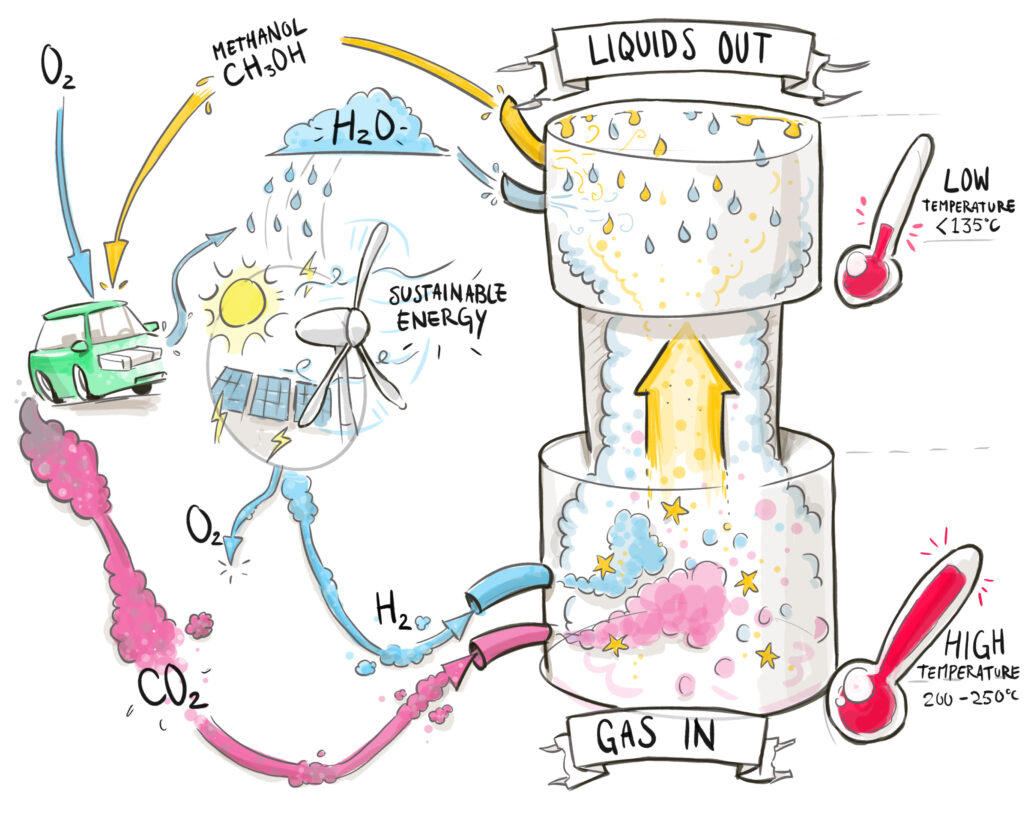Carbon is an essential element present in various aspects of our daily lives, playing a pivotal role in energy production, construction materials, food, textiles, and chemicals. However, the association between carbon emissions and climate change has brought significant attention to the ways we produce, use, and manage carbon. As carbon dioxide (CO2) emissions from burning fossil fuels and other industrial processes are major contributors to global warming, the urgency to address this issue has never been greater.
Currently, we consume 550 megatons of carbon-containing materials and energy. Nearly 88% of this comes from fossil resources, while 12% consists of CO2, recycling, and bio-carbon sources. By 2050, carbon usage is expected to double to 1,150 megatons. This raises a critical question: How can we transform carbon from single-use to circular use without CO2 emissions, at low cost, and on an industrial scale? Addressing this challenge is crucial for achieving sustainability goals and reducing the impact of climate change. Innovating and implementing circular carbon solutions will ensure that carbon remains a valuable resource, continuously recycled and reused. This transition involves rethinking production processes, developing new technologies, and creating robust systems for carbon capture, utilization, and recycling, ultimately leading to a more sustainable and resilient industrial landscape.
Our vision
Our vision for a circular carbon economy requires a paradigm shift in how we perceive and use carbon. Through collaboration, innovation, and policy changes, we can create a sustainable system where carbon circulates instead of being lost. The roadmap and adaptation pathways that ISPT develops together with partners form the foundation for a transformative future outlook.
What is Carbon?
Carbon is a complex topic, both in society and industry. Fundamentally, carbon is the backbone of life on Earth. We are made of carbon, we eat carbon, and our economies, homes, and means of transport are all built on carbon. We rely on carbon for our daily lives and advancements. However, this dependence is deeply entwined with one of the most serious problems we face today: global climate change.
While carbon has always been present in our atmosphere, the amount of carbon dioxide (CO2) has increased significantly due to human emissions since the start of the Industrial Revolution in 1750. During the Industrial Revolution, humans began extracting carbon-rich, energy-dense resources, such as fossil fuels, that had remained untouched for countless years. These advancements have led to the release of carbon back into the atmosphere as CO2, disrupting the natural carbon cycle.
The carbon cycle is the natural process by which carbon is exchanged between the atmosphere, oceans, soil, and living organisms. Plants absorb CO2 during photosynthesis, converting it into organic matter, which then moves through the food chain and returns to the atmosphere through respiration, decomposition, and combustion. This cycle helps regulate the Earth’s climate by controlling the concentration of CO2, a key greenhouse gas, in the atmosphere.
Carbon and climate change
Carbon dioxide in the atmosphere warms the planet, causing climate change. Human activities, particularly industrial ones, have increased atmospheric carbon dioxide levels, making it the primary greenhouse gas driving recent climate change. According to the UN, fossil fuels—coal, oil, and gas—are the largest contributors to global climate change, responsible for over 75% of global greenhouse gas emissions and nearly 90% of all carbon dioxide emissions. As greenhouse gas concentrations rise, so does the global surface temperature. The last decade is the warmest on record, with each decade since the 1980s being warmer than the previous one. Nearly all land areas are experiencing more hot days and heat waves.
Source: United Nations
Is carbon the problem?
The use of carbon is not the problem, but the challenge lies in its disposal, says Carol Xiao. Therefore, it is necessary to replace the aforementioned 88% with new carbon sources and associated technologies. What we definitely need to do is reduce and optimize our use of materials and energy, as well as promote reuse. Nevertheless, the demand for carbon remains significant. Therefore, we must increase recycling efforts. Additionally, the widespread use of non-fossil resources and the application of Carbon Capture and Utilization (CCU) technologies are essential.
At the Institute for Sustainable Process Technology (ISPT), we believe it is crucial to take a holistic view and understand the carbon demand. This allows us to collaborate with stakeholders in developing roadmaps or scenarios for the transformation towards a circular, industrial carbon chain. Four years ago, we established the ISPT Circular Carbon program, and we have since built a strong project portfolio in collaboration with our network.
Circular Carbon Program
In the Circular Carbon Program, we consider the following program lines:
1. Gasification for syngas production
This route explores the possibilities of producing syngas from waste streams through gasification, which can be a renewable source of carbon. ISPT is launching a project to assess the feasibility of a thermochemical waste recycling center aimed at producing high-quality syngas from waste streams such as plastics and biomass. This initiative will explore the potential for establishing an efficient recycling facility at location X, considering local feedstock availability and infrastructure requirements. Key activities include a literature review, feasibility study for future projections (2024, 2030, 2040), feedstock quality control, pre-treatment technique selection, plant design, syngas infrastructure planning, and socio-economic analysis.
The project will leverage expertise in waste management, chemical processing, process engineering, economic analysis, logistics, and market analysis, with ISPT coordinating contributions from industry leaders like Shell, BASF, Dow, Nobian, Sasol, SMEs, and knowledge institutes.
2. Renewable methanol routes:
Converting CO2 from the air combined with (green) hydrogen into methanol forms a circular and renewable fuel that does not emit new CO2 (LOGIC project). Due to the increasing availability of intermittently sustainable energy sources like hydrogen, long-term energy storage has become more crucial. Simultaneously, there is growing demand in the chemical industry for sustainable carbon feedstocks. The LOGIC technology addresses these needs by enabling the production of methanol from CO2 and H2 at mild temperatures and pressures, achieving nearly 100% carbon yield. This is achieved through an innovative reactor design incorporating internal gas recycling.

3. Electrochemical conversion of CO2

his technology focuses on converting CO2 into usable raw materials such as polymers and chemicals (SUNSOL project). The Sunsol project aims to develop cutting-edge technologies for the electrification of chemical conversions involving CO2 and H2O/H2. This initiative takes two approaches: direct electrification of chemical conversions via electrocatalysis of pre-captured CO2, and the integrated capture and conversion of CO2. The target products include CO, CH4, olefins, and methanol. The project is structured into four work packages: electrochemical CO2 reduction in supercritical CO2 to HCOOH, ethylene, or methane; single-step electrochemical conversion of CO2 to methanol using proton-conducting ceramic cells; electrification of integrated direct air capture (DAC) and conversion to light hydrocarbons; and techno-economic optimization and benchmarking of synthesis routes for different platform molecules.
Expected results include a validated scientific basis for the processes, comparative analysis and improvement suggestions for the routes, transfer of process design and evaluation data to industrial partners, and training of five high-quality R&D experts ready for industry careers.
4. Biocarbon
Biocarbon focuses on developing carbon-rich products from biological sources, contributing to reducing dependence on fossil fuels. The biocarbon sources for platform chemicals program aims to replace fossil-based feedstocks with bio-based alternatives. By deriving chemical building blocks from biomass sources such as agricultural crops (grains, beets, corn) and waste streams (forestry residues, sewage sludge, agricultural by-products), we can eliminate dependence on fossil fuels. This approach ensures a neutral impact on total greenhouse gas emissions, even with potential leakage, and can potentially reduce atmospheric greenhouse gases if carbon remains within a closed-loop system.
By comprehending how carbon circulates within our society and across diverse industrial sectors today, we can better optimise its utilization and conversion in the future.
– Insight from PROVE IT project
Carbon and Climate Change in EU Policy
The EU has established several policies to support the capture and storage of CO2, but to meet the 90% emissions reduction target for 2040 and achieve climate neutrality by 2050, efforts must be significantly scaled up. The Net-Zero Industry Act proposes storing at least 50 million tonnes of CO2 per year geologically by 2030. To meet future targets, approximately 280 million tonnes would need to be captured by 2040 and around 450 million tonnes per annum by 2050. Despite the large scale of this endeavor, equivalent to Sweden’s annual CO2 emissions in 2022, Europe currently has limited operational large-scale industrial carbon management projects. Therefore, a common EU-wide approach is essential to establish a single market for CO2, prompting the Commission to propose a strategy for a comprehensive framework on industrial carbon management.
Source: European Commission

